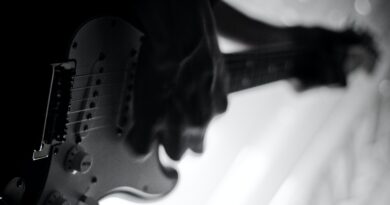How to Learn Guitar Chords
 Chords are three or more notes played simultaneously. They commonly fall under two categories, namely major chords and minor chords.
Chords are three or more notes played simultaneously. They commonly fall under two categories, namely major chords and minor chords.
Guitars have only five basic major chord patterns. These main chord patterns are C, A, G, E, and D. Together, they spell the word CAGED which should be an easy way of remembering them. The remaining chord patterns are all derived from these major chords that make up CAGED.
CAGED is a method of fret board patterns for chords and scales and is derived from the exclusive tuning of the guitar. Every other chord or scale as well as arpeggio can be made from these five patterns, and understanding as well as mastering this system is a huge achievement for any guitarist.
When you first learn guitar chords, it can be very tough to get your fingers to go to the right strings. After a few days of practice, however, your fingers will remember where to go. It is important to spend some time everyday with chords where you face a problem with, until you are comfortable playing them easily.
Keep in mind that it is normal for your fingertips to become a bit sore and tender when you first start out. But don’t worry. If they become too painful to the touch, stop practicing then and there and resume again the following day. With regular practice, you will notice that you have developed calluses on your fingertips but it should not be a problem.
To make another point to keep in mind is that if you hear a buzzing sound or feel that the sound of the notes being played is dull, then you may need to press harder on the strings, or it may be that one or more of your fingers is touching a close string. Remember that when you strum the chord, each note should not ring out distinctly. You may find it difficult at first to press all the strings down firmly but with time and practice, your hands will build up the strength soon.
The following tips will come in handy when you learn guitar chords.
* Do not let your fingernails grow too long otherwise they might prevent you from strumming the fret board properly.
* Ensure that your fingers are positioned straight up and downwards, or they may tend to mute other strings.
* While playing chords, your fingers must form an arch at the joints so that your fingertips and not the flat part of your finger can come in contact with the strings.
* Remember that the further your finger is from the fret the more difficult it is to apply the right amount of pressure, with the result that you will hear a buzzing sound.
* Another factor is that the size of your hand and the breadth of the guitar’s neck can make a big difference in determining which fingers you can use to play the chords. Most of the chord charts freely available on the web nowadays use the most frequently used chord fingerings.
* Patience, practice and devotion are the keywords when learning guitar chords.

Appreciate you sharing, great article. Great.
Everything is very open with a clear description of the issues.
It was truly informative. Your website is extremely
helpful. Thanks for sharing!
Thank you very much for such an informative article
The CAGED system is a great way to begin learning chords. Any time you can find patterns, especially ones you can easily see on the fretboard, your rate of learning will increase.
Thank you for your comment!